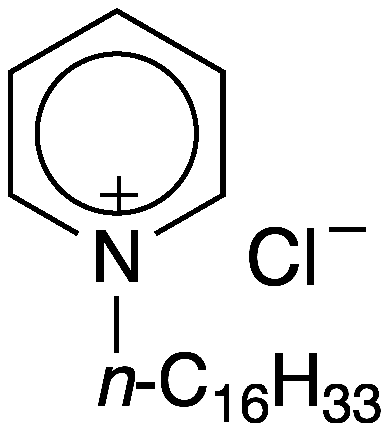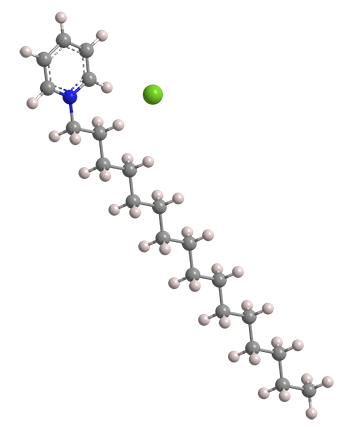What molecule am I?


Cetylpyridinium chloride (CPC) is a quaternary ammonium salt antiseptic that is used in many over-the-counter personal-care products: mouthwashes, toothpastes, lozenges, and breath and nasal sprays, to name a few. It is also used in topical anti-infective products and as a pharmaceutical preservative.
More formally known as 1-hexadecylpyridinium chloride, CPC first appeared in the chemical literature in the 1930s. An early account1 of its disinfecting properties was written by pharmacist C. Lee Huyck at Xavier University of Louisiana (New Orleans) in 1944.
As shown in the hazard information table, CPC by itself has some dangerous properties; but its concentrations in consumer products have been considered too small to be of concern—until recently. In 2020, Brian K. Shoichet at the University of California, San Francisco; Laszlo Urban at the Novartis Institutes for Biomedical Research (Cambridge, MA); and researchers at other institutions published a study showing that some supposedly inert pharmaceutical additives such as CPC have potential biological activity. But the results do not necessarily mean that the substances are toxic.
Some scientists, however, are a bit more suspicious of “quats”, as quaternary ammonium compounds are called in the industry. In the late 2000s, toxicologist Terry Hrubec at Virginia Tech and the Edward Via College of Osteopathic Medicine (both in Blacksburg, VA) noticed that some control mice embryos in a lab study acquired certain defects from two quat disinfectants, which were thought to be safe. Since then, she and other researchers have found more instances of quat-caused animal defects.
CPC has not been implicated in any of these studies; and no human health effects have been associated with exposure to quat-containing products. But this past March, enough evidence about defects in animals attributed to quats had been accumulated that the California Department of Public Health added these substances to its Biomonitoring California program.
1 Am. J. Pharm. 1944, 116, 50–59.
Cetylpyridinium chloride hazard information
| Hazard class* | Hazard statement | |
|---|---|---|
| Acute toxicity, oral, category 4 | H302—Harmful if swallowed | |
| Skin corrosion/irritation, category 2 | H315—Causes skin irritation | |
| Serious eye damage/eye irritation, category 1 | H318—Causes serious eye damage | |
| Acute toxicity: inhalation, category 2 | H330—Fatal if inhaled | |
| Specific target organ toxicity, single exposure, respiratory tract irritation, category 3 | H335—May cause respiratory irritation | |
*Globally Harmonized System of Classification and Labeling of Chemicals. Explanation of pictograms.
Cetylpyridinium chloride fast facts
| CAS Reg. No. | 123-03-5 |
| SciFinder nomenclature | Pyridinium, 1-hexadecyl-, chloride (1:1) |
| Empirical formula | C21H38ClN |
| Molar mass | 339.99 g/mol |
| Appearance | White crystals or powder |
| Melting point | 77 ºC |
| Water solubility | 68 g/L |

Learn more about this molecule from CAS, the most authoritative and comprehensive source for chemical information.
Molecule of the Week needs your suggestions!
If your favorite molecule is not in our archive, please send us a message. The molecule can be notable for its current or historical importance or for any quirky reason. Thank you!
Stay Ahead of the Chemistry Curve
Learn how ACS can help you stay ahead in the world of chemistry.

